4th Quarter Newsletter 2023
for the Leavenworth Nutcracker Museum
EARLY METAL NUTCRACKERS---17TH-19TH C
We continue our
studies of early metal nutcrackers and move into the 17th century.
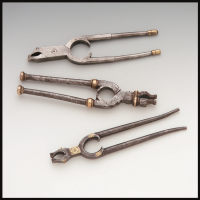 Metal
nutcrackers continued to be more and more popular and improvements in the
production of metals made it more profitable for the makers. Iron
was now plentiful as there were many foundries in England and the European
mainland. There were also foundries in the United States, the
first having been installed in 1642. Many times brass
was used as trim for the hand wrought nutcrackers making a more attractive
design.
Metal
nutcrackers continued to be more and more popular and improvements in the
production of metals made it more profitable for the makers. Iron
was now plentiful as there were many foundries in England and the European
mainland. There were also foundries in the United States, the
first having been installed in 1642. Many times brass
was used as trim for the hand wrought nutcrackers making a more attractive
design.
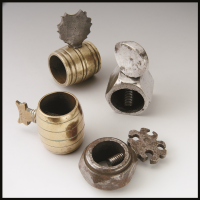 The
screw nutcrackers arrived in the 17th century as
this technology was now being applied to tools and other implements. Iron
and brass were forged to make small screw nutcrackers which men usually
carried in their pockets, hence the term ‘pocket screw’.
The
screw nutcrackers arrived in the 17th century as
this technology was now being applied to tools and other implements. Iron
and brass were forged to make small screw nutcrackers which men usually
carried in their pockets, hence the term ‘pocket screw’.
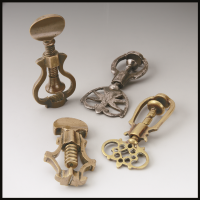 The
designs of the screw nutcrackers became more developed and complicated with
openwork cages and detailed patterns. The screw mechanism gives greater
control when cracking a nut, and it is easier to get a whole kernel with the
screw type than with the forceful compression of the lever.
The
designs of the screw nutcrackers became more developed and complicated with
openwork cages and detailed patterns. The screw mechanism gives greater
control when cracking a nut, and it is easier to get a whole kernel with the
screw type than with the forceful compression of the lever.
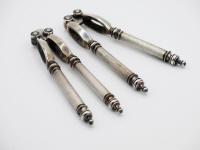 By
the eighteenth century the reversible nutcracker was designed with one lever
pivoting 360 degrees so the nutcracker could accommodate 2 sizes of nuts. These
nutcrackers are known as “flip-overs”.
By
the eighteenth century the reversible nutcracker was designed with one lever
pivoting 360 degrees so the nutcracker could accommodate 2 sizes of nuts. These
nutcrackers are known as “flip-overs”.
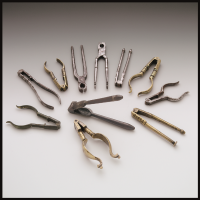 It
was not until the middle of the 19th century that a
process was discovered that allowed brass to be cast into molds. The
first castings were used for cartridge casings for firearms, but soon brass
was being used along with iron for many cast nutcrackers.
It
was not until the middle of the 19th century that a
process was discovered that allowed brass to be cast into molds. The
first castings were used for cartridge casings for firearms, but soon brass
was being used along with iron for many cast nutcrackers.
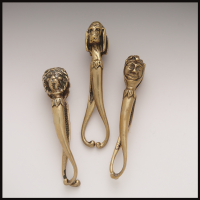 Although
brass nutcrackers were produced in France and other European countries, it
was Birmingham, England that became the brass capitol of the world.
Foundries that had been used in the production of iron were easily
transformed into the making of brass. Now that brass could be
molded, three
dimensional heads were often seen on hand-held levers. These
nutcrackers featuring a lion, dog and clown were made in England in the 19th century,
and measure a long 7.24 inches.
Although
brass nutcrackers were produced in France and other European countries, it
was Birmingham, England that became the brass capitol of the world.
Foundries that had been used in the production of iron were easily
transformed into the making of brass. Now that brass could be
molded, three
dimensional heads were often seen on hand-held levers. These
nutcrackers featuring a lion, dog and clown were made in England in the 19th century,
and measure a long 7.24 inches.
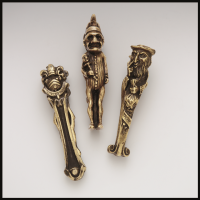
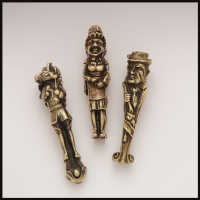
Many
nutcrackers were double faced with the same design on the opposite lever
while others appeared with a companion character on the opposite lever.
Shakespeare was a popular subject for nutcrackers and other
literature characters appeared. The nutcrackers pictured here
show the Winchester Crest and Trusty Servant, Punch and Judy, and on the
right are characters from Oliver Twist: Bill Sykes and Fagin,
the villainous character who kidnapped children and made them into thieves.
 This
was the Victorian age. Designs flourished and became more and
more detailed. Large figures were created in different metals
and in different countries. This eagle with crown was made
in Germany. It is beautifully crafted in bronze, with delicate
feathers, intricate majestic crown and sharp ferocious beak.
This
was the Victorian age. Designs flourished and became more and
more detailed. Large figures were created in different metals
and in different countries. This eagle with crown was made
in Germany. It is beautifully crafted in bronze, with delicate
feathers, intricate majestic crown and sharp ferocious beak.
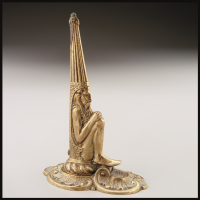 In
the late 19th century there were many
beautifully designed nutcrackers created by artisans in
England much to the delight of collectors. King Neptune is one
of their favorites. Sitting regally on his throne, he leans
forward to crack small nuts under his toes while he sits on larger nuts to
break the shells.
In
the late 19th century there were many
beautifully designed nutcrackers created by artisans in
England much to the delight of collectors. King Neptune is one
of their favorites. Sitting regally on his throne, he leans
forward to crack small nuts under his toes while he sits on larger nuts to
break the shells.
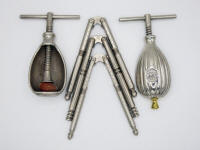 In
the United States, steel nutcrackers were patented by H.M. Quackenbush in
1889. Designed for home use, millions of these nutcrackers
have been produced. Steel, used where extra strength is
needed, is made of iron with carbon as a hardening agent and other elements
such as manganese and nickel. Chromium is added to make
stainless steel.
In
the United States, steel nutcrackers were patented by H.M. Quackenbush in
1889. Designed for home use, millions of these nutcrackers
have been produced. Steel, used where extra strength is
needed, is made of iron with carbon as a hardening agent and other elements
such as manganese and nickel. Chromium is added to make
stainless steel.
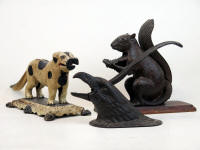 Other
nutcrackers produced in the United States during this time were cast of
iron, and made to crack the hardest of nuts. Unlike today when
nuts can be purchased already shelled, many times in the 19th century
the shelling of nuts was done by the children in the home. Certainly
these character nutcrackers made the job much easier!!
Other
nutcrackers produced in the United States during this time were cast of
iron, and made to crack the hardest of nuts. Unlike today when
nuts can be purchased already shelled, many times in the 19th century
the shelling of nuts was done by the children in the home. Certainly
these character nutcrackers made the job much easier!!
Contact Us
Monday - Saturday 11-5pm
Sunday - 11-4:30pm
We suggest visitors arrive at least 30 minutes before closing.

 Nutcracker
Museum
Nutcracker
Museum











